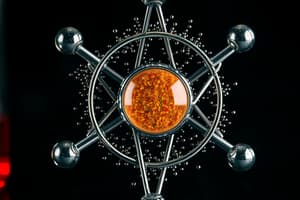Podcast
Questions and Answers
What is the primary difference between a chemical change and a physical change?
What is the primary difference between a chemical change and a physical change?
- A chemical change involves a change in the state of matter, while a physical change involves a change in the composition of matter.
- A chemical change involves a change in the atomic number, while a physical change involves a change in the molecular formula.
- A chemical change involves a change in the molecular formula, while a physical change involves a change in the atomic number.
- A chemical change involves a change in the composition of matter, while a physical change involves a change in the state of matter. (correct)
Which of the following indicators is NOT a sign of a chemical change?
Which of the following indicators is NOT a sign of a chemical change?
- The evolution of a gas.
- The formation of a precipitate.
- A change in color of the reactant. (correct)
- A change in temperature.
What is the atomic theory concept that states that atoms of an element are identical in mass and properties?
What is the atomic theory concept that states that atoms of an element are identical in mass and properties?
- The Law of Conservation of Mass.
- The Atomic Unity Principle.
- The Law of Multiple Proportions.
- The Law of Definite Proportions. (correct)
What type of reaction involves the combination of two or more substances to form a new compound?
What type of reaction involves the combination of two or more substances to form a new compound?
What is the purpose of an indicator in a chemical reaction?
What is the purpose of an indicator in a chemical reaction?
Flashcards are hidden until you start studying
Study Notes
Chemistry Concepts Assessment
- Atomic theory is a fundamental concept in chemistry, encompassing the composition and structure of atoms, including protons, neutrons, and electrons.
- Chemical change involves the transformation of one substance into another, often resulting in a change in properties, such as color, odor, or state.
- Physical change, on the other hand, is a alteration in the form or state of a substance, but not its chemical composition, examples include melting, freezing, and condensation.
- Indicators of chemical change include:
- Color change
- Gas evolution
- Formation of a precipitate
- Temperature change
- Simple reaction types include:
- Synthesis reactions (combining two or more substances to form a new compound)
- Decomposition reactions (breaking down a single compound into two or more simpler substances)
- Replacement reactions (replacing one element with another in a compound)
- Combustion reactions (burning of a substance, often releasing heat and light)
Chemistry Key Concepts
- Atomic theory: a fundamental concept in chemistry that describes the nature of atoms and their composition
- Chemical change: a process where one or more substances are transformed into new substances with different properties and composition
- Physical change: a process where a substance changes its state or form, but its chemical composition remains the same
- Indicators of chemical change: signs that a chemical reaction has occurred, such as:
- Change in color or appearance
- Evolution of gas or heat
- Formation of a precipitate
- Change in temperature
- Simple reaction types: common types of chemical reactions, including:
- Synthesis reactions: two or more substances combine to form a new substance
- Decomposition reactions: a single substance breaks down into two or more simpler substances
- Replacement reactions: one element replaces another element in a compound
- Combustion reactions: a substance reacts with oxygen to produce heat and light
Studying That Suits You
Use AI to generate personalized quizzes and flashcards to suit your learning preferences.




